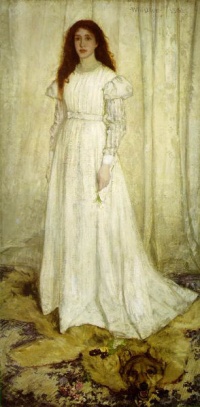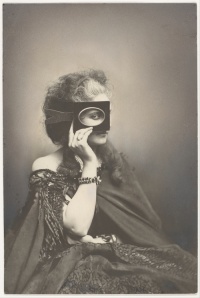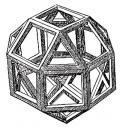1860s
From The Art and Popular Culture Encyclopedia

James Whistler's painting Symphony in White, No. 1: The White Girl (1862) caused controversy when exhibited in London and, later, at the Salon des Refusés in Paris. The painting epitomizes his theory that art should essentially be concerned with the beautiful arrangement of colors in harmony, not with the accurate portrayal of the natural world.

Scherzo di Follia (circa 1863-66): Virginia Oldoini, Countess of Castiglione photographed by French photographer Pierre-Louis Pierson

A Clearing in the Woods (1865) by Pierre-Auguste Renoir
|
Related e |
|
Featured: |
| << 1850s | 1870s >> | |
|---|---|---|
The 1860s were an extremely turbulent decade with numerous cultural, social, and political upheavals in Europe and America. The abolition of slavery in America led to the breakdown of the Atlantic slave trade, which was already suffering from the abolition of slavery in most of Europe in the late 1820s and '30s. In America, civil war led to total war and after the war, the turmoil continued with the rise of white supremacist organizations like the Ku Klux Klan and the issue of granting Civil Rights to freed blacks.
In France, the Salon des Refusés in 1863 invited art-works rejected for display at the Paris Salon of 1863. Many consider this the birth of modern art. Absinthe becomes popular in Europe.
[edit]
Literature and arts
- Artificial Paradises (1860) by Baudelaire
- Phryné Before the Areopagus (1861) by Jean-Léon Gérôme
- The Turkish Bath (1862) by Jean Auguste Dominique Ingres
- Le déjeuner sur l'herbe (1863) by Manet
- The Birth of Venus (1863) Alexandre Cabanel
- The Painter of Modern Life (1863) by Baudelaire
- Notes from Underground (1864) by Fyodor Dostoevsky
- Alice's Adventures in Wonderland (1865) by Lewis Carroll
- Olympia (1865) by Manet
- History of Caricature and Grotesque in Literature and Art (1865) by Thomas Wright
- War and Peace (1865-69) by Leo Tolstoy
- L'Origine du monde, painted by Courbet in 1866, first publicly displayed in 1995
- Das Kapital (1867) by Karl Marx
- Thérèse Raquin (1867) by Émile Zola
- Woman in the Waves (1868) by Gustave Courbet
- La Danse (1869) by Jean-Baptiste Carpeaux
- The Songs of Maldoror (1868-69) by Comte de Lautreamont
[edit]
Births
- Georges Méliès (1861 - 1938)
- Arthur Schnitzler (1862 - 1931)
- Gustav Klimt (1862 - 1918)
- Rupert Carabin (1862 - 1952)
- Claude Debussy (1862 - 1918)
- Edvard Munch (1863 - 1944)
- Luigi Pirandello (1867 - 1936)
- Gaston Leroux (1868 - 1927)
- Paul Chabas (1869 - 1937)
[edit]
See also
Unless indicated otherwise, the text in this article is either based on Wikipedia article "1860s" or another language Wikipedia page thereof used under the terms of the GNU Free Documentation License; or on research by Jahsonic and friends. See Art and Popular Culture's copyright notice.

